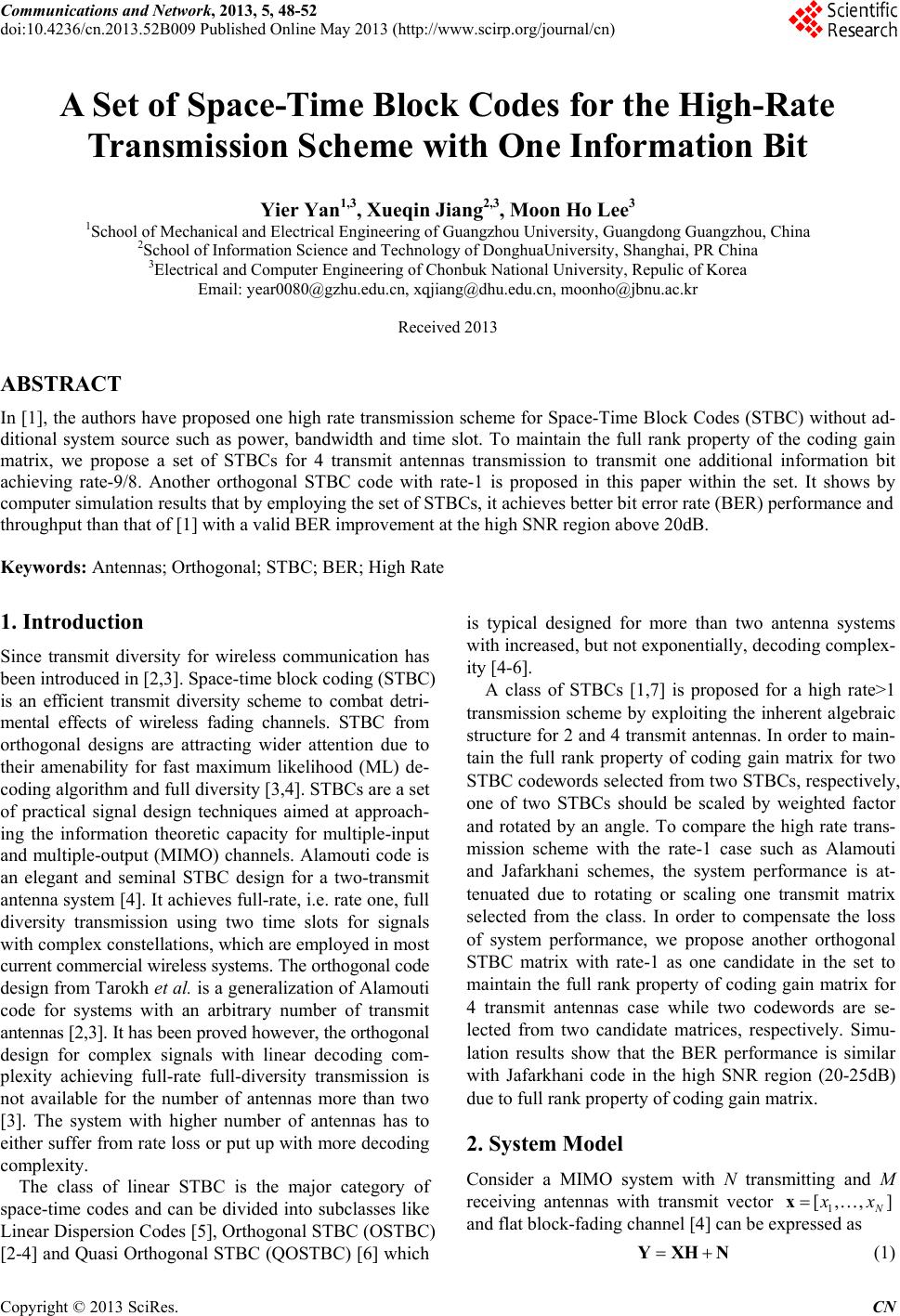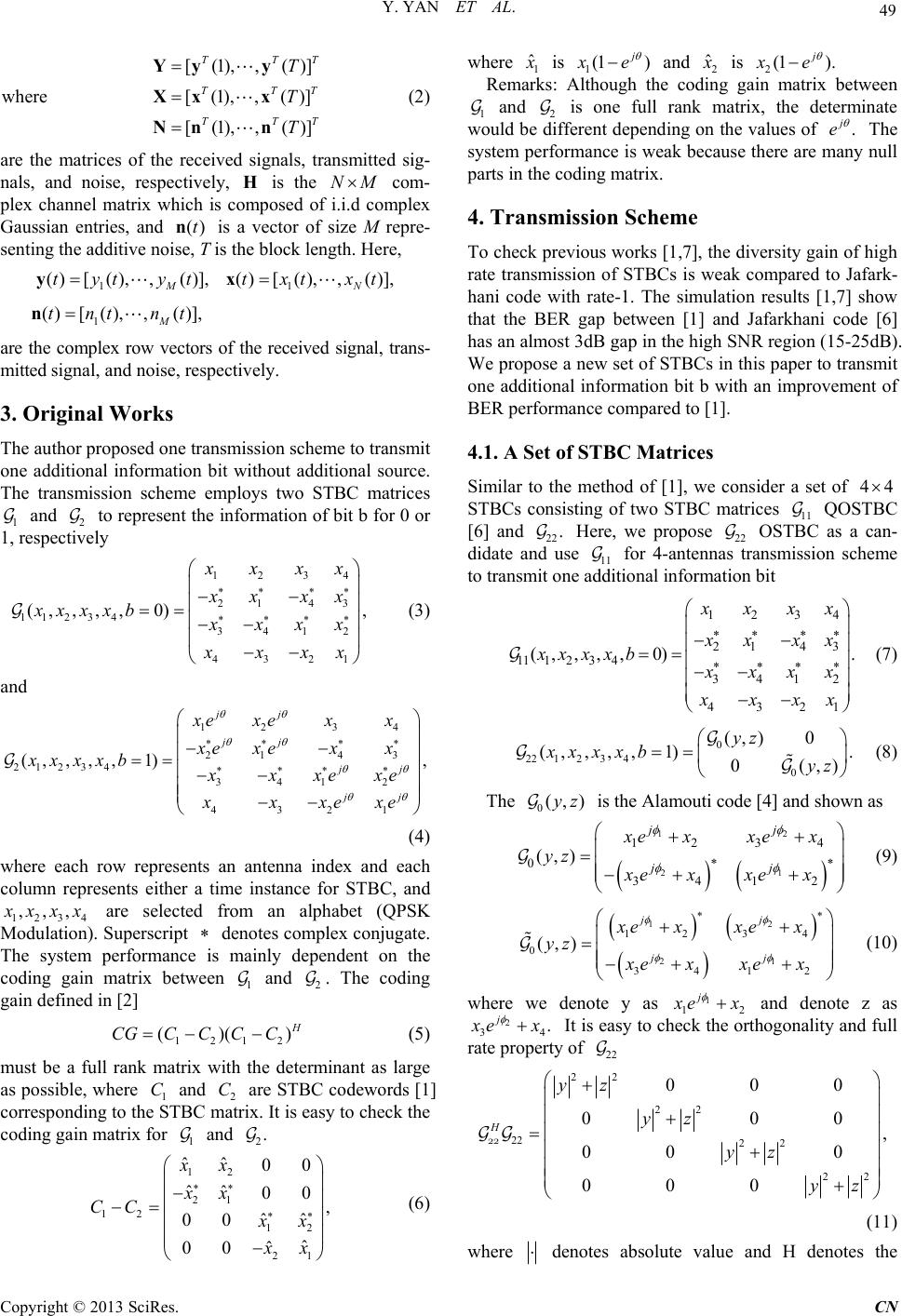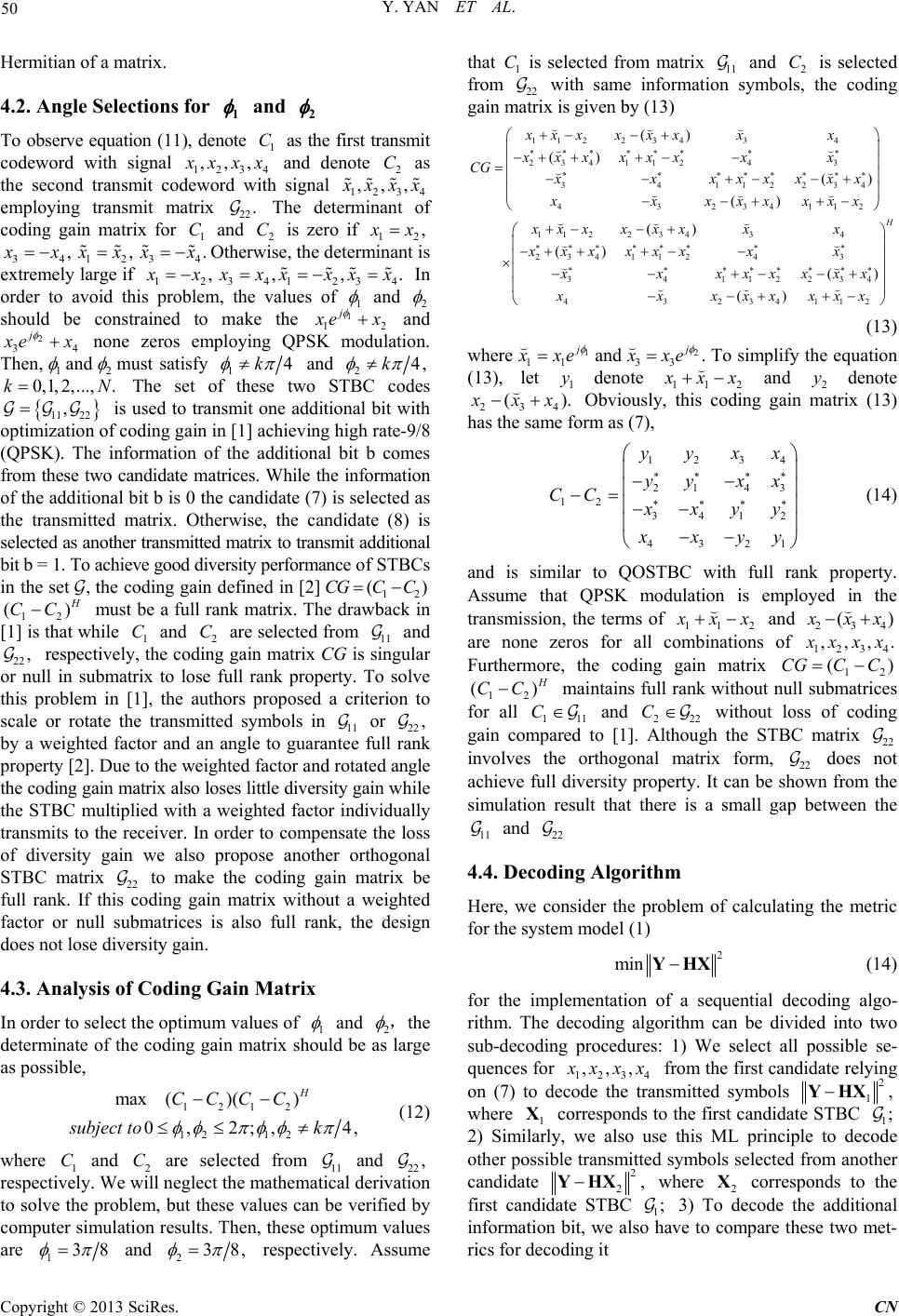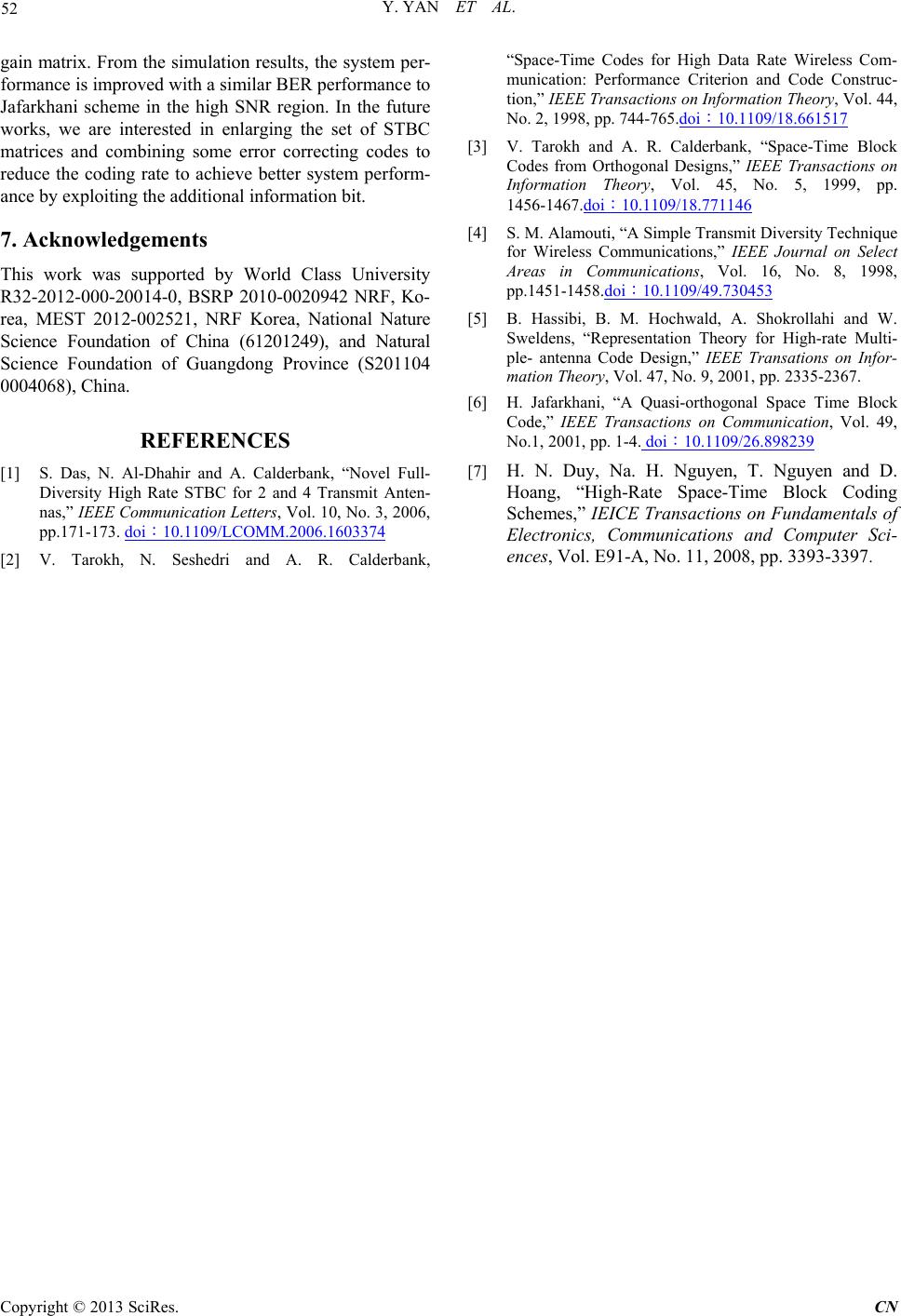 Communications and Network, 2013, 5, 48-52 doi:10.4236/cn.2013.52B009 Published Online May 2013 (http://www.scirp.org/journal/cn) A Set of Space-Time Block Codes for the High-Rate Transmission Scheme with One Information Bit Yier Yan1,3, Xueqin Jiang2,3, Moon Ho Lee3 1School of Mechanical and Electrical Engineering of Guangzhou University, Guangdong Guangzhou, China 2School of Information Science and Technology of DonghuaUniversity, Shanghai, PR China 3Electrical and Computer Engineering of Chonbuk National University, Repulic of Korea Email: year0080@gzhu.edu.cn, xqjiang@dhu.edu.cn, moonho@jbnu.ac.kr Received 2013 ABSTRACT In [1], the authors have proposed one high rate transmission scheme for Space-Time Block Codes (STBC) without ad- ditional system source such as power, bandwidth and time slot. To maintain the full rank property of the coding gain matrix, we propose a set of STBCs for 4 transmit antennas transmission to transmit one additional information bit achieving rate-9/8. Another orthogonal STBC code with rate-1 is proposed in this paper within the set. It shows by computer simulation results that by employing the set of STBCs, it achieves better bit error rate (BER) performance and throughput th an that of [1] with a valid BER improvement at the high SNR region above 20dB. Keywords: Antennas; Orthogonal; STBC; BER; High Rate 1. Introduction Since transmit diversity for wireless communication has been introd uced in [2,3]. Space-tim e bloc k cod ing (ST BC) is an efficient transmit diversity scheme to combat detri- mental effects of wireless fading channels. STBC from orthogonal designs are attracting wider attention due to their amenability for fast maximum likelihood (ML) de- coding algorithm and full diversity [3,4]. STBCs are a set of practical signal design techniques aimed at approach- ing the information theoretic capacity for multiple-input and multiple-output (MIMO) channels. Alamouti code is an elegant and seminal STBC design for a two-transmit antenna system [4]. It achieves full-rate, i.e. rate one, full diversity transmission using two time slots for signals with complex constellations, which are employed in most current commercial wireless systems. The orthogonal code design from Tarokh et al. is a generalization of Alamouti code for systems with an arbitrary number of transmit antennas [2,3]. It has been proved however, the orthogonal design for complex signals with linear decoding com- plexity achieving full-rate full-diversity transmission is not available for the number of antennas more than two [3]. The system with higher number of antennas has to either suffer from rate loss or put up with more decoding complexity. The class of linear STBC is the major category of space-time codes and can be divided into subclasses like Linear Dispersion Codes [5], Orthogonal STBC (OSTBC) [2-4] and Quasi Orthogonal STBC (QOSTBC) [6] which is typical designed for more than two antenna systems with increased, but not exponentially, d ecoding complex- ity [4-6]. A class of STBCs [1,7] is proposed for a high rate>1 transmission scheme by exploiting the inherent algebraic structure for 2 and 4 transmit antennas. In order to main- tain the full rank property of coding gain matrix for two STBC codewords selected from two STBCs, respectively, one of two STBCs should be scaled by weighted factor and rotated by an angle. To compare the high rate trans- mission scheme with the rate-1 case such as Alamouti and Jafarkhani schemes, the system performance is at- tenuated due to rotating or scaling one transmit matrix selected from the class. In order to compensate the loss of system performance, we propose another orthogonal STBC matrix with rate-1 as one candidate in the set to maintain the full rank property of coding gain matrix for 4 transmit antennas case while two codewords are se- lected from two candidate matrices, respectively. Simu- lation results show that the BER performance is similar with Jafarkhani code in the high SNR region (20-25dB) due to full rank property of coding gain matrix. 2. System Model Consider a MIMO system with N transmitting and M receiving antennas with transmit vector 1 [, ,] xx and flat block-fading channel [4] can be expressed as YXHN (1) Copyright © 2013 SciRes. CN  Y. YAN ET AL. 49 is 1(1 ) e is 2(1 ). j e gain matrix bet where (2) [(1),,()] [(1),,()] [(1),,()] TT TT TT T T T Yy y Xx x Nn n T T T are the matrices of the received signals, transmitted sig- nals, and noise, respectively, is the com- plex channel matrix which is composed of i.i.d complex Gaussian entries, and is a vector of size M repre- senting the additive n oise, T is the block length. Here, HNM ()tn 1 ( )[( ),,( )], M tyt yty 1 ( )[( ),,( )], N txt xtx 1 ( )[( ),,( )], M tnt ntn are the complex row vectors of the received signal, trans- mitted signal, and noise, respectively. 3. Original Works The author proposed one transmission scheme to transmit one additional information bit without additional source. The transmission scheme employs two STBC matrices 1 and 2 to represent the information of bit b for 0 or 1, respectively 1234 21 43 11234 3412 4321 (, ,,,0), xxx xxx xxxxb xxx xxx (4 where each row represents an antenna index and e (3) and 12 34 21 43 21234 3412 4321 (, ,, ,1), jj jj jj jj xe xexx xe xexx xxxxb xxxexe xxxexe ) ach column represents either a time instance for STBC, and 1234 ,,, xxx are selected from an alphabet (QPSK Superscript denotes complex conjugate. The system performance is mainly dependent on the coding gain matrix between 1 and 2 . The coding gain defined in [2] Modulation). 1212 ()() CG CCCC (5) must be a full rank matrix with the determinant as large as possible, where 1 C and 2 C are STBC codewords [1] corresponding to theTBC mrix. It is easy to check the coding gain matrix for 1 and 2. ˆ Sat 12 21 12 12 21 ˆ00 ˆˆ00 , ˆˆ 00 ˆˆ 00 xx xx CC x x 1 ˆ and 2 ˆ (6) where Reme co and is one full rank matrix, the uldfferent depending on the values of arks: Although thding ween determinate 1 wo 2 be di . e The m performance is weak because there are mny null thg matri 4. m mulation results [1,7] show d Jafarkhani code [6] SNR region (15-25dB). syste a parts ine codinx. Transission Scheme To check previous works [1,7], the diversity gain of high rate transmission of STBCs is weak compared to Jafark- hani code with rate-1. The si that the BER gap between [1] an has an almost 3dB gap in the high We propose a new set of STBCs in this paper to transmit one additional information bit b with an improvement of BER performance compared to [1]. 4.1. A Set of STBC Matrices Similar to the method of [1], we consider a set of 44 STBCs consisting of two STBC matrices QOSTBC [6] and Here, we propose 11 OSTBC as a ission 22.22 s tr tion can- scheme didate and use 11 for 4-antenna to transmit one additional informaansm bit 12 4 21 43 11 1234 3412 (,, , ,0). 3 4321 xxx xxx xxxxb xxx xx (7) x ) The is the Alamouti code [4] and shown as 0 22 1 2340 (,) 0 (, ,, ,1). 0(, yz xxxxb yz (8) 0(,)yz 12 21 123 4 0 3412 (,) jj jj xe xxex yz xexxe x (9) jj 12 21 12 3 4 0 3412 (,) jj xe xxex yz xexxex j (10) where we denote y as 1 12 ex and denote z as 2 34 . j ex rate properIt is easy to chorthogonality and full ty of eck the 22 22 2 22 00 0 , 00 0 y yz 2 22 22 000 000 H yz z yz (11) where denotes absolute value and H denotes the Copyright © 2013 SciRes. CN  Y. YAN ET AL. 50 Hermitian of a matrix. 4.2. Angle Selections for 1 and 2 To observe equation (11), denote as the first transmit codeword with signal 1 C 234 , 1 ,, xx deword x with and denote as the second transmit cosignal 2 C 234 ,, 1, xx an x terminemploying transmit me de gatrix 22 . Tht of coding ain matrix for 1 C and 2 C is zero if 12 , x 34123 , , . 4 xx xxx Otherwise, the determinant is extremely large if 1 2 , , 341 2 ,34 . x x , thxx xx In 1 x forder to avoid this probleme values o and 2 1 j should be constrained to he make t12 ex and 2 34 j ex none zeros employinQPSK modulation. Then, 1 g and 2 must satisfy 14k and 24,k 0,1,2,..., .kN The set of these two ST 11 22 , is used to transmne additional bit with optimization of coding ga in [1] achieving high f the additional bit b comes from these two canion of the additional bit b is 0 the candidate (7) is lected the transmitted matrix. Otherwise, the c8) is another transmitted matrix to transmit additional bit b = 1. To achieve good divrmance coding gain defined in [2] 12 ()CGC C BC codes rate- rmat ( STB it in n o te matr ersity o ices. W per 9/8 fo as te f Cs (QPSK). The informatio dida selected as in the set , the hile fo th and e in se ida o 12 () CC mu g the STBC m of d st be a full rank matrix. The drawback in [1] is that while 1 C and 2 C are selected from 11 and 22 , respectively, the coding g ain matrix CG is singular or null in submatrix to lose full rank property. To solve this problem in [1], the authors proposed a criterion to scale or rotate the transmitted symbols in 11 or 22 , by a weighted factor and an angle to guarantee full rank property [2]. Due to the weighted factor and rotated angle the codingain matrix also lo ses lit tle divers ultiplied with a weighted factor individually transmits to the receiver. In rder to compensate the loss iversity gain we also propose another orthogonal STBC matrix 22 to make the coding gain matrix be full rank. If this coding gain matrix without a weighted factor or null submatrices is also full rank, the design does not lose divers ity gain. 4.3. Analysis of Coding Gain Matrix In order to select the optimum v alues of 1 ity gai lein wh o and 2 , the determinate of the coding gain matrix should be as large as possible, 1212 12 12 max( )( ) 0, 2;,4, H CCCC subject tok (12) where and are selected from and deriv fi 1 2 respectively. We will neglect th e mathematical C C11 n be 22 , ation ed by to solve the problem, but these values caveri computer simulation results. Then, these optimum values are 138 and 238, respectively. Assume that 1 C is selected from matrix and is selected from with same informatmhe coding gainx is given by (13) 11 ion sy2 C bols, t ma22 tri 2 x x 1122 3434 ()xxxx xxxx x xx 3 4 11243 34112234 43234112 1122 3434 234 1124 () () () () () xx xxxxx CG xxxxxxxx xxxxxxxx xxxx xxxx x xxx 3 34112234 43234112 () () xxxxxx xxxxxxxx xx (13) where 1 11 xe and 2 33 . j xe note 11 To simpe equation (13 e2 lify th ), let 1 y d xx a denote nd 2 y 234 (). xx e sam h O e form bvi gairix (13) ously, this as (7), codingn m 4 3 2 1 x x at has t 123 21 4 12 341 432 yyx yy x CC xyy xyy n i (14) milar OSTBC t dulatios n, and is to Qwith full rank property. Assume thaQPSK mo employed in the tranthe terms of 112 si issiosm xx and 234 () xx are none zeros for all combinations of 1234 ,,,. xxx Furthermore, the coding gaintrix ma12 ()C CCG 12 () CC r all fo maintains full rank 1 without null submatrices 11 C and 22 2 C ou oue ST a erty with gh th trix form . It can t to [1]. h versity be c stem , los BC 22 show s of coding matrix gain com involves t achieve , we p fu ared e ort ll di Alth ogonal m prop 22 does not n from the h simulation result that there is a small gap between the 11 and 22 4.4. Decoding Algorithm Hereonsider the problem of calculating the metric for the sy model (1) 2 min YHX () for the implementation of a sequential decoding algo- rithm. The decoding algorithm can be divided into two sub-decoding procedures: 1) We select all possible se- nces f 14 quer o1234 ,,, xxx from the first candidate relying mbols on (7) to decode the transmitted sy2 1,YHX where X corresponds to th 1 1 2) Similarly, we also use this ML principle to decode other possible transmitted e first candidate STBC symbols selected from candi ; another date 2 2,YHX where date STBC3) To 2 corresponds to the decode the additional X first candi 1; information bit, we also have to compare these two met- rics for decoding it Copyright © 2013 SciRes. CN  Y. YAN ET AL. 51 22 2 YHX (15) The b information is dependent on minimum me between these two metrics substituting previous decod- ing results into first step. 5. Numerical Results In this section, some simulation results demonstrate va- lidity of the propose 1 YHX it tric d transmission scheme. QPSK modu- lation and flat fading channel are consid lations. Two combinations of ered in all simu- 1 and 2 are shown to verify the BER performance depending on different val- ues of 1 and 2 in Figure 1. Figure 2 shows the BER performances versus SNR to compare the proposed design with the QOSTBC (7) nal high rate desi1] and receiving anhe gh vaR 10-2he re 1 gn [ tennas. T 0dB. T ate design [6] and conventio equipped with 4 transmitting system performance of the proposed OSTBC 22 (8) deserves a similar performance with 11 above 20dB. In the high SNR region 20-25 dB of 11 , the BER per- formance of the proposed hi rate-98 transmission scheme is similar to the QOSTBC case, but there also exists aisible gp in the low SN / region ason is that the system performance depends on 11, 22 and coding gain matrix between them, and the curve should deserve a similar form with 11 and 22 . Moreover, the BER performance of proposed design is almost 2dB away from the conventional high r-9/8 design with power scaling or angle rotation [1] at the BER of 5 10 . In Figure 3, the effective throughput performance is shown to compare the proposed scheme and the original works [1]. The effective throughput is defined as 2(1 ),RFER where R is the space-time code rate FER means the frame error rate, and each frame [2] and Figure 2. BER performance of high rate design for 4 an- tennas. Figure 3. Effective throughputs of high rate design for 4 ntennas. contains 9 bits information. In the high SNR region a 0FER similar to Figure 2 that the $FER$ corre- sponds to BER and the BER performance of the pro- posed scheme is better than that of [1], the proposed transmission scheme achieves 2.25 bits per channel transmission whereas the effective throughput of the QOSTBC is 2 bits. A crossing point exits at a SNR level of 12dB. Similarly, the effectiv e throughput performance of high rate-9 /8 [1] is also simulated in this figure. From 10dB to 20dB of SNR, the effective throughput has been improved compared to [1] due to low FER in the pro- posed design. 6. Conclusions to transmit one additional information bit A new set of STBCs including OSTBC and QOSTBC is proposed achieving high rate-9/8. The OSTBC is an candidate in the set to maintain the full rank property of the coding Figure 1. BER performance of high rate design w ith differ- ent angles. Copyright © 2013 SciRes. CN  Y. YAN ET AL. Copyright © 2013 SciRes. CN 52 gain matr -20014-0, BSRP 2010-0020942 NRF, Ko- 02521, NRF Korea, National Nature of China (61201249), and Natural ix. From the simulation results, the system per- formance is improved with a similar BER performance to Jafarkhani scheme in the high SNR region. In the future works, we are interested in enlarging the set of STBC matrices and combining some error correcting codes to reduce the coding rate to achieve better system perform- ance by exploiting the additional information bit. 7. Acknowledgements This work was supported by World Class University R32-2012-000 rea, MEST 2012-0 Science Foundation Science Foundation of Guangdong Province (S201104 0004068), Chin a. REFERENCES [1] S. Das, N. Al-Dhahir and A. Calderbank, “Novel Full- Diversity High Rate STBC for 2 and 4 Transmit Anten- nas,” IEEE Communication Letters, Vol. 10, No. 3, 2006, pp.171-173. doi:10.1109/LCOMM.2006.1603374 [2] V. Tarokh, N. Seshedri and A. R. Calderbank, “Space-Time Codes for High Data Rate Wireless Com- munication: Performance Criterion and Code Construc- tion,” IEEE Tra, Vol. 44, nsactions on Information Theory No. 2, 1998, p/18.661517p. 744-765.doi:10.1109 [3] V. Tarokh and A. R. Calderbank, “Space-Time Block Codes from Orthogonal Designs,” IEEE Transactions on Information Theory, Vol. 45, No. 5, 1999, pp. 1456-1467.doi:10.1109/18.771146 [4] S. M. Alamouti, “A Simple Transmit Diversity Technique for Wireless Communications,” IEEE Journal on Select Areas in Communications, Vol. 16, No. 8, 1998, pp.1451-1458.doi:10.1109/49.730453 [5] B. Hassibi, B. M. Hochwald, A. Shokrollahi and W. Space Time Block Sweldens, “Representation Theory for High-rate Multi- ple- antenna Code Design,” IEEE Transations on Infor- mation Theory, Vol. 47, No. 9, 2001, pp. 2335-2367. [6] H. Jafarkhani, “A Quasi-orthogonal Code,” IEEE Transactions on Communication, Vol. 49, No.1, 2001, pp. 1-4. doi:10.1109/26.898239 [7] H. N. Duy, Na. H. Nguyen, T. Nguyen and D. Hoang, “High-Rate Space-Time Block Coding Schemes,” IEICE Transactions on Fundamentals of Electronics, Communications and Computer Sci- ences, Vol. E91-A, No. 11, 2008, pp. 3393-3397.
|